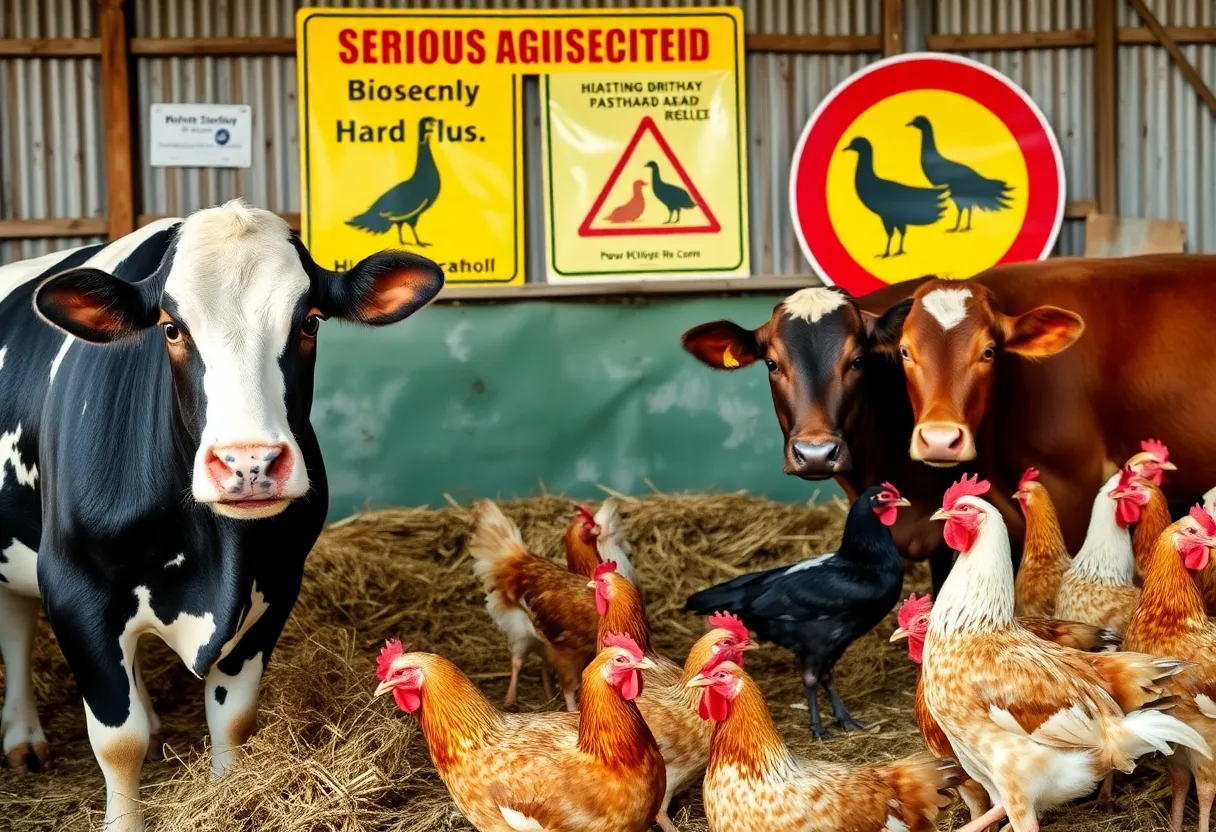News Summary
California is grappling with a significant H5N1 bird flu outbreak that has impacted agriculture and public health. The virus has spread to all states, causing over 70 reported human infections. With California’s dairy farms hit hard, Governor Newsom declared a state of emergency. Experts warn of possible human-to-human transmission and call for improved biosecurity measures. The CDC is monitoring the situation, emphasizing vaccinations for livestock workers to mitigate risks. Public health officials are on high alert as misinformation poses additional challenges to effective communication about this escalating threat.
California is currently facing a significant public health threat as the H5N1 bird flu virus has spread across all 50 states in the U.S., prompting experts to sound the alarm about the potential for a new pandemic by 2025. Passed increasingly from wildlife to dairy cattle and humans, the outbreak has resulted in more than 70 reported human infections, one of which has resulted in death.
The Global Virus Network (GVN) recently issued a warning about the H5N1 outbreak, highlighting the dramatic effects on agriculture, particularly in dairy farming. Approximately 1,000 dairy cow herds nationwide have been affected by the virus, and over 765 infected dairies have been reported in California alone. To address the crisis, California Governor Gavin Newsom declared a state of emergency in December 2024, aiming to contain the outbreak among dairy farms. Currently, with 613 dairies having recovered from quarantine, the San Joaquin Valley has borne the brunt of the outbreak, accounting for nearly 85% of California’s bird flu cases.
The widespread culling of poultry has also been alarming, with more than 168 million birds eliminated to mitigate the virus’s spread since 2022. Interestingly, the bird flu virus, which typically infects avian species, has recently been discovered to move from infected wild birds to cattle. Milking equipment is suspected to contribute to the virus’s transmission among dairy cows, with some workers reporting flu-like symptoms after working in milking parlors.
Public health experts urge immediate action to prevent further transmission of the virus and call for improvements in surveillance and biosecurity measures. They emphasize preparing for potential human-to-human transmission, especially as sporadic cases of human infections have occurred without direct contact with infected animals. This raises concerns that the virus may be adapting to spread more easily among humans. Experts are particularly worried about the possibility of the H5N1 strain mixing with seasonal flu viruses, potentially increasing both its transmissibility and severity among the population.
The Centers for Disease Control and Prevention (CDC) is actively monitoring the situation across the United States, collaborating with state officials to track new human infections. The CDC is also recommending vaccinations for livestock workers against seasonal flu to reduce the chances of H5N1 transmission to humans and manage the public health risks associated with the outbreak.
Though officials state that the general public’s risk of contracting the virus remains low, livestock workers are at a heightened risk. Symptoms of H5N1 infection in humans can include high fever, cough, sore throat, muscle aches, and potentially a rapid progression to severe respiratory illness, which could complicate overall health outcomes. The University of California has reported significant financial impacts on consumers due to the loss of egg-laying poultry, estimating a cost increase of $1.3 billion for California egg consumers.
The GVN scientists have noted continued circulation of the virus in wild birds and backyard flocks, pointing to the increasing risk this poses to both animals and humans. Additionally, misinformation surrounding the wellness industry may impede effective communication about the risks associated with H5N1 and contribute to its spread.
Experts stress that enhanced regulation and oversight of zoonotic diseases—those that can be transmitted from animals to humans—are essential to prevent further cross-species transmissions. As the United States confronts this ongoing bird flu outbreak, the situation remains under close scrutiny as public health officials brace for potential developments that could affect people and livestock nationwide.
Deeper Dive: News & Info About This Topic
- North Jersey: H5N1 Outbreak and New Pandemic Fears
- Wikipedia: H5N1 Influenza
- Delaware Online: H5N1 Virus Pandemic Concerns
- Google Search: H5N1 Bird Flu Pandemic
- STAT News: Raw Pet Food and H5N1
- Encyclopedia Britannica: Bird Flu
- CBS News: Bird Flu Pandemic Potential
- Google News: H5N1 Virus 2025
- Democrat and Chronicle: H5N1 Bird Flu Spread

Author: STAFF HERE HOLLYWOOD
The Hollywood Staff Writer represents the experienced team at HEREHollywood.com, your go-to source for actionable local news and information in Hollywood, Los Angeles County, and beyond. Specializing in "news you can use," we cover essential topics like product reviews for personal and business needs, local business directories, politics, real estate trends, neighborhood insights, and state news affecting the area—with deep expertise drawn from years of dedicated reporting and strong community input, including local press releases and business updates. We deliver top reporting on high-value events such as the Hollywood Bowl summer concerts, the Hollywood Christmas Parade, film premieres at TCL Chinese Theatre, and festivals at the Magic Castle. Our coverage extends to key organizations like the Hollywood Chamber of Commerce and Visit Hollywood, plus leading businesses in entertainment, dining, and tourism that define the local economy. As part of the broader HERE network, including HERELosAngeles.com, HEREBeverlyHills.com, HEREAnaheim.com, and HEREHuntingtonBeach.com, we provide comprehensive, credible insights into Southern California's dynamic landscape.





